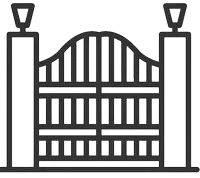Identifying Problems Early Helps Maintain Your Fence’s Longevity
Fences are essential for defining property boundaries, ensuring security, and adding aesthetic value. Over time, they can face wear and tear due to weather conditions or physical damage. Identifying issues early can save you from costly replacements and maintain your fence’s functionality. This guide will help you spot common problems that indicate your fence requires attention.
Signs of Structural Damage
One major sign that a fence needs repair is structural damage. If you notice leaning sections or posts that wobble, it may be time for fence repair. Such issues often arise when the soil around the posts has shifted or due to decay in wooden fences. Catching these signs early ensures safety and prolongs the lifespan of the structure.

Look for Rot and Decay
Wooden fences are prone to rot and decay, particularly if they have not been treated against moisture. Look out for soft spots or areas where the wood appears discolored. When detected, immediate fence repair is crucial to prevent further degradation. Regular maintenance like sealing can help minimize this risk.
Inspect for Rust on Metal Fences
Metal fences can suffer from rust over time, especially when exposed to rain. Rust weakens the structure and makes it susceptible to breaks. During your inspection, check joints and hinges thoroughly as these areas frequently accumulate rust. Applying anti-rust paint can offer protection but remember to address any repairs swiftly once rust is observed.
Check for Loose or Broken Boards
A loose or broken board not only looks unsightly but can also compromise the security and privacy provided by a fence. Periodically walk along the perimeter, applying slight pressure to test stability. Fixing individual boards promptly helps maintain the overall integrity without resorting to full-scale repairs.
Gaps and Holes Indicating Pest Activity
Gaps or holes in your fence can be a telltale sign of pest activity. Small animals or insects may chew through wooden fences, creating weaknesses. These damages necessitate repair efforts to avoid further incursions. Using rodent repellents and pest-resistant materials can alleviate future occurrences.
Sagging Sections Indicate Foundation Problems
Sagging sections in a fence often indicate foundational problems beneath. Soil erosion or improper initial installation might cause this issue. Addressing sagging immediately with professional help ensures that such underlying causes do not result in larger replacement costs down the line.
- Identify wobbly posts or leaning sections
- Check for signs of wood rot or decay
- Inspect metal parts for rust buildup
- Tighten or replace loose boards promptly
- Fill gaps caused by pests quickly
- Correct any sagging sections with expert assistance
The Importance of Regular Inspections
Regular inspections help catch minor issues before they escalate into major problems. By routinely checking each part of the fence, you’re more likely to spot potential hazards early on. Consistent upkeep prevents small defects from evolving into expensive repairs.
Benefits of Timely Repairs
Carrying out timely repairs on your fence saves money in the long run. It avoids complete replacements and maintains the appearance and function of your property boundary. Additionally, taking action quickly minimizes safety risks associated with weakened structures.

Contact Professionals for Major Repairs
If you encounter severe damage that requires more than routine fixes, contacting professionals is vital. They provide comprehensive services that ensure every problem is addressed effectively. Expertise guarantees that all aspects of the fence are restored correctly.
Your Trusted Partner for Fence Maintenance
For those living in Oceanside, CA, reach out to Maryland Fences at (760) 521-5167 for expert advice and solutions regarding your fencing needs. We understand how important secure boundaries are to you and offer reliable repair services tailored to extend the life of your investment.
